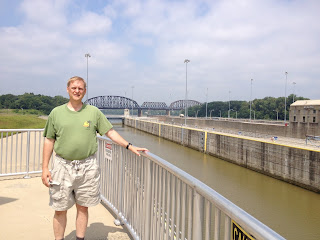Day 10 began with a search for the Falls of the Ohio overlook by Daniel Boone during his exploration of Kentucky. And not only did we find it tucked away behind a run-down neighborhood, but we found the 1200 ft long by 110 ft wide McAlpine (Twin) Locks & Dam, a culmination since 1825 of trying to overcome the major obstruction to navigation of the entire Ohio River. Here, the river dropped 26 ft in a distance of 2.5 miles and navigation was treacherous and seasonal over the rapids.
In the Falls Interpretive Center we learned about how the retreat of the Ice Age glaciers in combination with the tectonic shifts that brought us the mountains also exposed the Devonian fossil beds plentiful here, from 390 million years ago. The rapids and falls are a natural stopover for many migrating birds and nearly 300 species have been observed here, so that even John James Audobon studied and painted birds here around the time of Daniel Boone's move to Missouri in 1800.
George Rogers Clark was a soldier from Virginia and the highest ranking American military officer on the northwestern frontier during the American Revolutionary War. He served as leader of the Kentucky militia throughout much of the war and by age 30 had severely weakened the British hold on the Northwest Territory via his capture of several important forts. He was one of the founders of Louisville and a friend of Daniel Boone. His younger brother, Captain William would eventually meet Captain Meriwether Lewis at the Falls in 1803 and agree to explore the Louisiana Territory down the Ohio and up the Mississippi and Missouri Rivers all the way to the Pacific Ocean for three years returning in 1806.
We were able to visit the home site of William Clark where his brother George also stayed, and then nearby photograph the mouth of Mill Creek where the famous Lewis and Clark epic 8000 mile expedition departed from. You can see the stone foundations of the buildings, a view of the Ohio River, and a little forest creature having lunch.
Finally, we traveled to the north of the state to Big Bone Licks, which Daniel had discovered during his solo exploration of the Kentucky wilderness back in 1770. There he came upon huge bones and tusks of Mammoths. We were able to hike the actual buffalo (bison) trace that led to the salt licks and see the park's own herd resting in the shade of the early evening.
"Here the prehistoric past is enshrined, containing the remains of some of America’s early animal inhabitants. Once covered with swamps, the land that makes up Big Bone Lick had a combination of minerals and water that animals found difficult to resist. For centuries great beasts of the Pleistocene era came to the swampy land in what is now known as northern Kentucky to feed. Animals that frequented Big Bone Lick included bison, both the ancient and modern variety, primitive horses, giant mammoths and mastodons, the enormous stag-moose, and the ground sloth.
Through the millenniums untold numbers of these great beasts came to Big Bone Lick. Carnivorous animals that fed off the flesh of these herbivores in turn followed them. Early man found a seemingly endless supply of food to hunt in and around these mineral and salt deposits. The lands at Big Bone Lick may have seemed inviting, but it had a deadly surprise in store for those animals that wandered onto the soft, unstable ground that made up the area. As they fed, many of the larger beasts began to sink into what the early pioneers to Kentucky called “jelly ground.” The bog-like soil could not support the weight of these enormous creatures and they sank helplessly into the quagmire beneath them."






































No comments:
Post a Comment